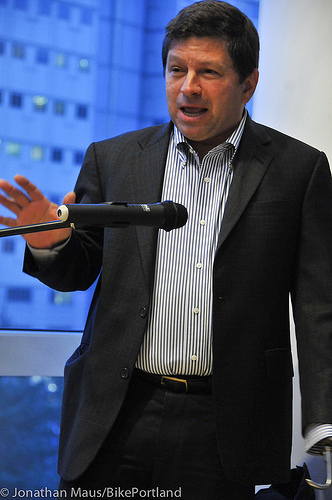
Green Lane Project event earlier this week.
(Photo © J. Maus/BikePortland)
The ways people talk about active transportation seems to be changing in Portland, both inside and outside of government.
At a unanimous City Council vote Wednesday in favor of $20.7 million in federally backed walking and biking improvements throughout the city, including $9.1 million to enact parts of the East Portland in Motion plan and $6.6 million for what promises to be a historic upgrade of central Portland bike facilities, people on both sides of the council dais were repeating an idea that isn’t always common: Improving biking improves the city for people who don’t.
Leading the shift: new Transportation Commissioner Steve Novick, who echoed and rephrased some of the observations we shared from his speech two nights before.
“It should be obvious to everybody that the freight improvements are connected to economic development,” Novick said Wednesday, referring to $4.1 million dedicated to efficient truck movement. “But the things that make it easier to walk and bike are economic investments. … There’s a couple of ways to improve your family’s economic position. One is to make more money, and one is to reduce your expenses. Active transportation investments help people reduce their expenses.”
The city said it would match $22.2 million in federal flexible funds, which would be awarded by regional agency Metro, with $2.6 million in local money for a total of $24.8 million in freight and active transportation projects. Full details are on the city’s website.
Novick also noted that more comfortable sidewalks, street crossings and bike lanes help businesses by cutting their health care costs.
“It’s obvious to people that when people bike, they’re healthier,” Novick said. “They’re also healthier when they have access to transit … because they’re walking.”
Commissioner Nick Fish, following Novick in voting to prioritize the biking and walking projects, congratulated the commissioner on what he said was Novick’s “finest speech to date” from the council bench.
Another theme that emerged: adding clearer separation between auto, bike and foot traffic, using physical barriers or simply more dedicated space, improves things for people on foot.
“One of the ways to make downtown more welcoming is to be able to walk on a one-way street and not have a bicycle coming at you,” said Charles Johnson, who testified at the hearing. “Are any city resources being expended to make the majority of the Portland population get around without being made to come face to face with a selfish cyclist on a sidewalk?”
Prompted by a question from Fish, Bicycle Transportation Alliance Advocacy Director Gerik Kransky testified along similar lines, though he phrased things differently.
“We’ve become victims of our own success,” Kransky said, talking about the quantity of bike and foot traffic in the central city. “It used to be that a multi-use path 10 to 14 feet in width was the gold standard. … We’re finding that that’s not enough.”
The Hawthorne Bridge’s sidepaths are 10 feet wide. TriMet’s new bridge, which will also be shared by people biking and walking, will be 14 feet in each direction.
Some of the grant money will go to improving bike connections on the west landing of that new bridge.
“That section will open the door to bikes and pedestrians from the entire Southeast Portland neighborhood to the South Portland area,” said Roger Gertenrich, a former mayor of Salem who now lives near the South Waterfront.
Economic growth and pedestrian comfort weren’t the only issues raised Wednesday; many said the projects would improve safety for people on bikes and foot.
“They’re not just about livability, though that’s important,” Novick said, just before casting his vote in favor of the citywide sheaf of projects. “They’re not just about global warming, though that’s important. They’re not just about safety, though that’s very important. They’re also economic investments. Aye.”


